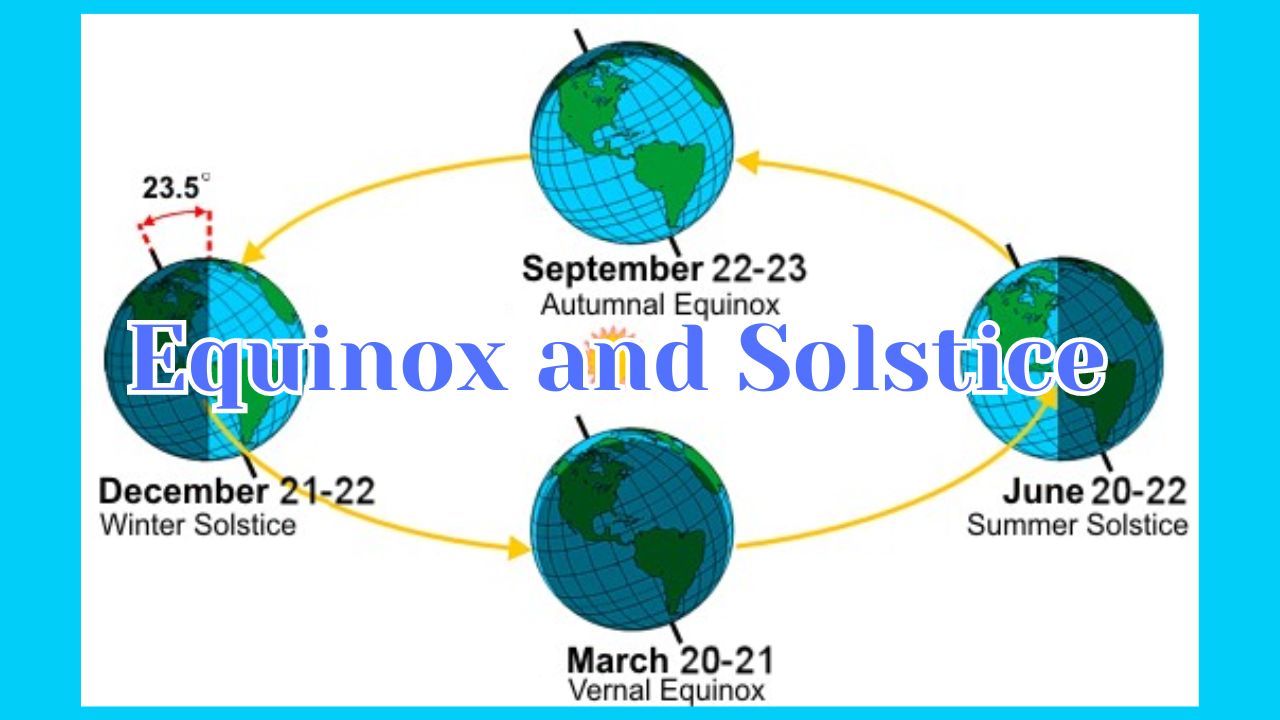
Equinox and Solstice#
Introduction#
This article trying to help you understand
- Why Solstice and Makarsankranti doesn’t happens on the same day?
- What are different movement or rotation of earth?
- Why there are many seasons on the earth?
Length of Day and Night#
- In sanskrit Divas is always 24 hours. Duration of day (Din) and night (Raatri) varies every day and it depends upon sunrise and sunset.
- Solstice (अयनांत = अयन + अंत), Equinox (विषुव)
- Equinox - An event when day and night are of equal duration. It happens on 20/21-Mar and 22/23-Sep.
- Solstice - An event when day is the longest or night is the longest. In northern hemisphere, day is longest on 20/21-Jun, Night is longest on 21/22-Dec.
- The word “tropic” refers to a region of the Earth where the Sun appears directly overhead at least once during the year, causing the Sun to be at its highest point in the sky at noon. There are two main tropics:
- Tropic of Cancer (Karka): This is the northernmost circle of latitude on Earth where the Sun can appear directly overhead at least once during the year. It’s located at approximately 23.5 degrees north of the equator.
- Tropic of Capricorn (Makar): This is the southernmost circle of latitude on Earth where the Sun can appear directly overhead at least once during the year. It’s located at approximately 23.5 degrees south of the equator.
- When there is Spring (Vasant) in the north hemisphere there is Autumn (Patjhad/fall) in the south and vice versa.
- Patjhad of Bharat = Fall of USA = Autumn of other English speaking countries.
- There is no relationship between Tropic of Cancer (Karka) and Karka Raashi (Cancer Zodiac sign) and Tropic of Capricorn (Makar) and Makar Rasshi (Capricorn Zodiac sign). I need more discussion with expert on this.
- Cancer, Capricorn or any other Zodiac sign are related to the constellation seen in sky from the earth.
- Cancer, Capricorn are two imaginary lines (that makes circle on the northen and southern hemisphere respectably)
Six Seasons of Bharat#
In India, traditionally, the year is divided into six seasons, each roughly lasting two months. These seasons are based on the Hindu calendar and are:
Vasanta (Spring): Lasting from mid-March to mid-May, this season signifies the arrival of spring with blooming flowers and pleasant weather.
Grishma (Summer): Spanning mid-May to mid-July, this season brings intense heat and dry weather across most parts of the country.
Varsha (Monsoon): From mid-July to mid-September, the monsoon season arrives, bringing heavy rainfall and cooler temperatures.
Sharad (Autumn): Extending from mid-September to mid-November, this season features clear skies, cooler temperatures, and the gradual transition from monsoon to winter.
Hemanta (Pre-winter): Lasting from mid-November to mid-January, this season marks the onset of winter, with cooler temperatures but not as harsh as the peak of winter.
Shishira (Winter): From mid-January to mid-March, winter sets in with colder temperatures, particularly in the northern regions of India.
These seasons are significant in various cultural and agricultural contexts across the country, influencing festivals, crop cycles, and traditional practices.
Planes of Movement#
- The orbital plane refers to the imaginary, flat surface or plane that a celestial body, such as a planet or a moon, follows as it orbits around another body, like a star (e.g., the Sun) or a planet (e.g., Earth’s orbit around the Sun).
- Orbital plan can tile over thousands of year but generally it remains same.
- Earth’s rotational axis is tilted at an angle of approximately 23.5 degrees relative to its orbital plane around the Sun
- Rotational plane tile can also change over thousands of year due to gravitational forces, but year to year it reamins same.
Distance#
- Earth moves around the sun in elliptical shape, not circular. Ellipse has 2 radius, unlike 1 radius of the circle.
- The difference between the two radii is about 5 million KM. The average distance from the Earth to the Sun (the semi-major axis) is roughly 150 million KM, while the closest approach (perihelion) is around 147 million KM and the farthest point (aphelion) is about 152 million KM.
- Season change happens because of earth’s 23.5 degree bent around the main axis. Earth moves around its axis in
Important Question#
- Why 23-Dec is not considered Makar Sankranti, why to wait for 9 + 15 = 24 days, for Makar Sankranti?
Answer to the Question#
- Length of day start increasing from 22-Dec. This is astronomical phenomena, which is physical and real.
- But zodiac sign are perceived phenomena. The sky is divided into 12 equal parts. This all is part of astrology, and there is little difference between physical reality and perceived reality.
- Makar Rekha concept is from astrology (not from astronomy), therefore, as per astrology sun enters into Makar rekha on 15-Jan. This is the only festival of Bharat which happens on same English calendar date of the year.


Comments: